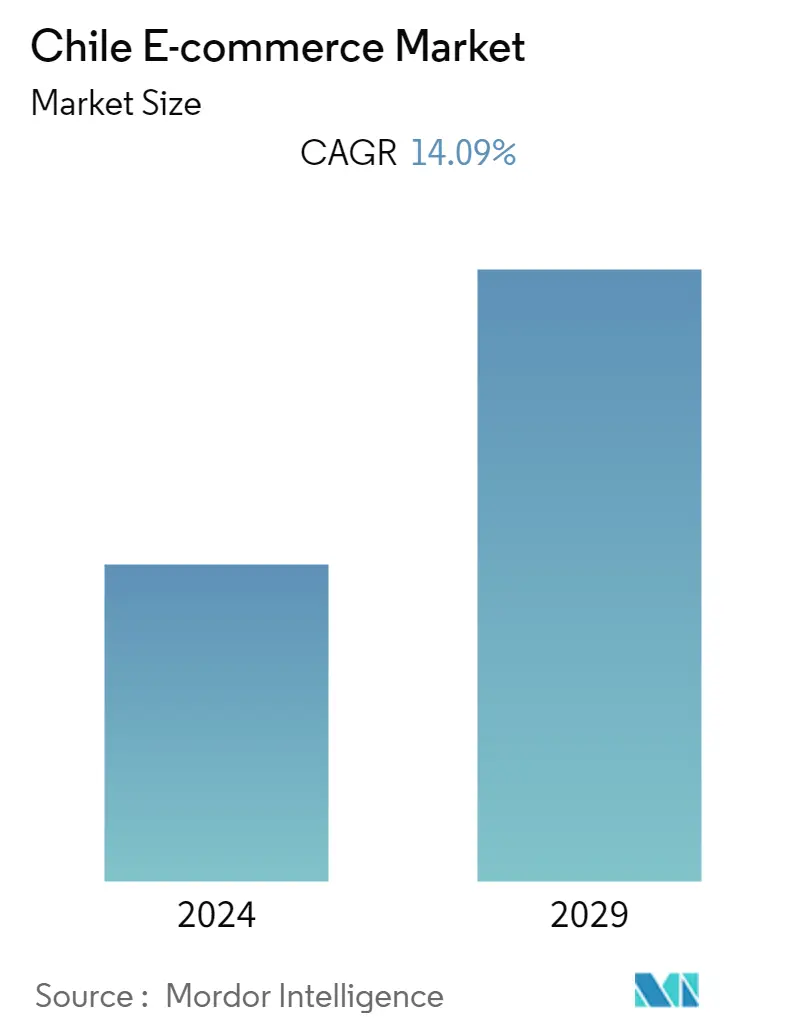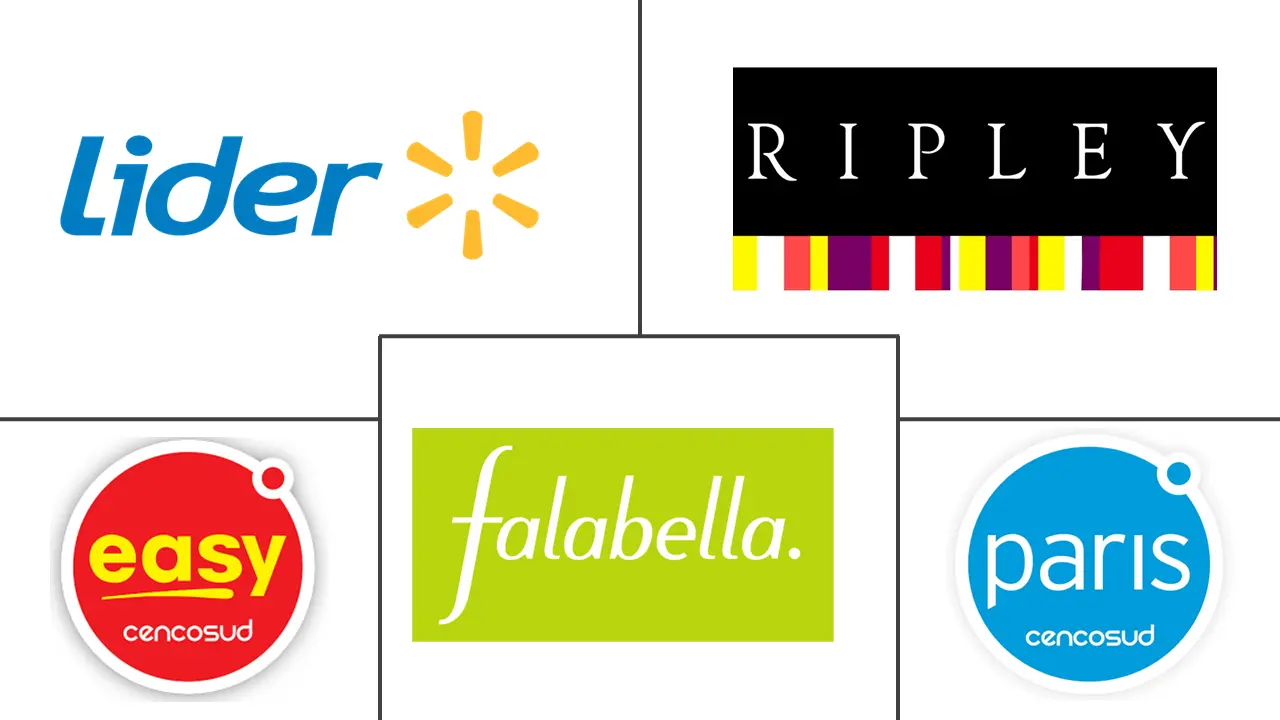Market Size of Chile E-commerce Industry

| Study Period | 2019 - 2029 |
| Base Year For Estimation | 2023 |
| Forecast Data Period | 2024 - 2029 |
| Historical Data Period | 2019 - 2022 |
| CAGR | 14.09 % |
| Market Concentration | Medium |
Major Players
*Disclaimer: Major Players sorted in no particular order |
Need a report that reflects how COVID-19 has impacted this market and its growth?
Chile E-commerce Market Analysis
Chile E-commerce Market is expected to grow at a CAGR of 14.09% from 2022 to 2027. Chile's top e-commerce sites include retail and supermarket stores such as Falabella, Ripley, Paris, Jumbo, and Lider and market places such as Linio, Mercado Libre, and Yapo. The most popular platforms for food and purchase deliveries are Cornershop, Rappi, Uber Eats, and PedidosYa.
- Amazon remains an excellent option for local customers, and it now includes innovative products from Chilean businesses; however, some brands do not ship internationally. Even so, local consumers are willing to be a part of international online purchases in order to access a broader range of products and prices. Amazon has been offering free shipping to Chile for purchases of $49 or more in eligible products since April 2021.
- International platforms like Amazon and AliExpress, which have massively reduced shipping times and made e-commerce more accessible, have contributed to the enormous growth in Chile e-commerce market. Last year, Correos de Chile collaborated with AliExpress to reduce delivery times from a maximum of 60 days to a window of 16 to 38 days.
- Since Amazon, Walmart, and Aliexpress remain dominant, smaller startups are emerging to compete. As more Chileans go online, primarily via smartphones, the challenge will be to provide faster delivery across the country while making m-commerce more accessible in the chile e-commerce market.
- Chile's E-commerce sales are expected to increase by 23% in 2021. Growth has exceeded the previous year's expectations due to the COVID-19 pandemic, pension fund withdrawals, and government fiscal stimulus. eCommerce has previously experienced positive growth over the last decade due to Chile's rapid and ongoing technological infrastructure development.
- The COVID-19 pandemic is shown in the increased demand for services that allow the virtual interaction of teleworking activities and software that provides virtual meetings, conference rooms, and classes. To facilitate access to medicines during the pandemic, the Chilean Ministry of Health authorized the online sale of medicine, resulting in substantial growth of online prescriptions.
Chile E-commerce Industry Segmentation
E-commerce is the purchasing and selling of products and services over the Internet. It is conducted over computers, mobiles, tablets, and other smart devices. There are primarily two types of e-commerce, including Business-to-Consumer (B2C) and Business-to-Business (B2B).
The Chile E-commerce Market is segmented by B2C E-Commerce (Beauty and Personal Care, Consumer Electronics, Fashion and Apparel, Food and Beverage, Furniture and Home), and B2B E-Commerce. In addition, Toys, hobbies & DIY, Electronics & Media, Fashion, Furniture & Appliances, and Food & Personal Care account for the majority of E-commerce revenue in Chile.
| By B2C e-commerce | ||||||||
| Market size (GMV) for the period of 2017-2027 | ||||||||
|
| By B2B e-commerce | |
| Market size for the period of 2017-2027 |
Chile E-commerce Market Size Summary
The e-commerce market in Chile is experiencing significant growth, driven by the increasing penetration of mobile internet and the widespread adoption of online payment methods. Major players like Falabella, Ripley, and Lider dominate the market, while international platforms such as Amazon and AliExpress have enhanced accessibility and reduced shipping times, further boosting the sector's expansion. The COVID-19 pandemic accelerated this growth by increasing demand for digital services and facilitating online sales of essential goods, including medicines. Government initiatives like Matriz Digital aim to bridge the technological gap, promoting digital development and infrastructure investment, including 5G implementation, to support the burgeoning e-commerce landscape.
Chilean consumers are increasingly turning to online shopping, with a notable shift towards mobile commerce. The market is characterized by a mix of established retailers and emerging startups, all vying to capture the growing online consumer base. Innovations such as Falabella's introduction of an electric e-commerce truck highlight the industry's commitment to sustainability and efficiency. As more Chileans embrace online shopping, the challenge remains to enhance delivery speed and expand m-commerce accessibility. The market's growth trajectory is supported by favorable economic conditions, technological advancements, and strategic partnerships, positioning Chile as a key player in the Latin American e-commerce arena.
Chile E-commerce Market Size - Table of Contents
-
1. MARKET INSIGHTS
-
1.1 Market Overview
-
1.2 Industry Attractiveness-Porter's Five Force Analysis
-
1.2.1 Bargaining Power of Suppliers
-
1.2.2 Bargaining Power of Buyers/Consumers
-
1.2.3 Threat of New Entrants
-
1.2.4 Threat of Substitute Products
-
1.2.5 Intensity of Competitive Rivalry
-
-
1.3 Key market trends and share of e-commerce of total Retail sector
-
1.4 Impact of COVID-19 on the e-commerce sales
-
-
2. Market Segmentation
-
2.1 By B2C e-commerce
-
2.1.1 Market size (GMV) for the period of 2017-2027
-
2.1.2 Market Segmentation - by Application
-
2.1.2.1 Beauty & Personal Care
-
2.1.2.2 Consumer Electronics
-
2.1.2.3 Fashion & Apparel
-
2.1.2.4 Food & Beverage
-
2.1.2.5 Furniture & Home
-
2.1.2.6 Others (Toys, DIY, Media, etc.)
-
-
-
2.2 By B2B e-commerce
-
2.2.1 Market size for the period of 2017-2027
-
-
Chile E-commerce Market Size FAQs
What is the current Chile E-commerce Market size?
The Chile E-commerce Market is projected to register a CAGR of 14.09% during the forecast period (2024-2029)
Who are the key players in Chile E-commerce Market?
Falabella, Ripley, Lider, Paris (Cencosud), Easy and Reebok are the major companies operating in the Chile E-commerce Market.

